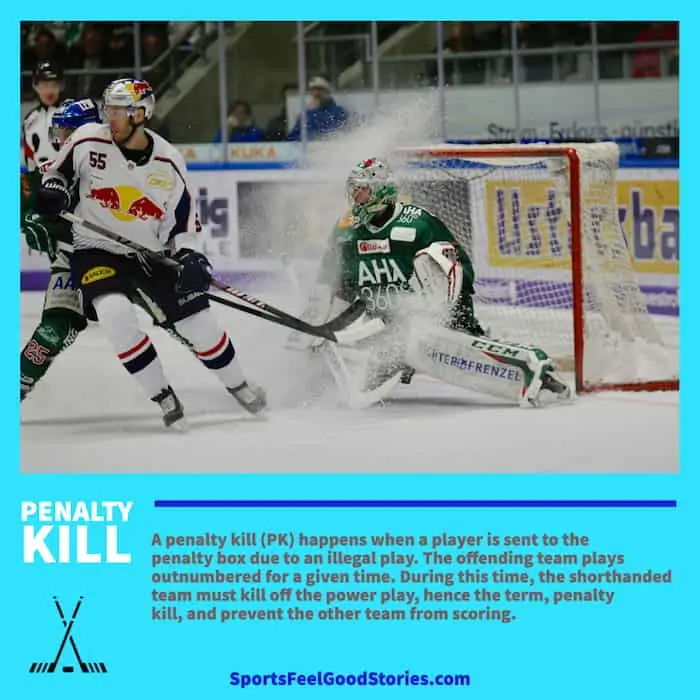With every power play comes the need for a penalty kill. And when your team is down in numbers and goals, this can be the worst-case scenario imaginable. Penalty kill strategies help a defensive team reduce scoring opportunities.
A Penalty Kill Definition
The definition of a penalty kill: It occurs when a player is sent to the penalty box due to an illegal play. The offending team plays outnumbered for a given time. During this time, the shorthanded team must kill off the power play (PP), hence the term, penalty kill, and prevent the other team from scoring.
Key Takeaways
A team is on a penalty kill (PK) when they are playing shorthanded for a set time due to a player infraction.
There are three basic penalty kill strategies: The Box, The Diamond, and The Wedge or Triangle +1.
Those on the penalty kill must also be sure to win face-offs, ice the puck, and defend the slot.

Key Penalty Kill Strategies
There are three main penalty kill strategies. And while every team on a penalty kill will make an extra effort to win face-offs and drive the puck out of the zone, these strategies go a little deeper. Each one will be used based on the power play strategy employed by the other team.
The Box
The first PK strategy we will look at is called The Box. It is often used against the Overload power play, an older and lesser-used strategy. It involves the PP attackers along the half boards. They intend to outnumber the defensemen three-to-two.
In the Box strategy, the idea is to box in the attackers. The team that is on the PK lets the attacking team have the puck. The purpose of this is to keep the attackers along the perimeter of the rink. They are less interested in chasing the puck carrier and would rather cut off the passing lane.
Each of the four players on the ice – two forwards, and two defensemen – needs to have their heads on a swivel. They need to be aware of all possible passes and player moves. Check out this video below to get a better sense of this strategy.
Simple Box Strategy Video
The Diamond
Now I can hear some of you asking, isn’t a diamond essentially a box titled? Yes, it is, but the tilt is what makes it different. The undermannned team reposition themselves based on the position of the power play strategy or where the quarterback is. The quarterback is the attacker playing the point.
If you recall the strategies used in a PP, then you may remember the Umbrella strategy. It makes the shape of an umbrella. This is where the Diamond PK best comes into play. The quarterback is at the center of the umbrella and the Diamond shape allows for a forward to defend against the point attacker.
Then, they will space out another two players to cover the rest of the top of the umbrella formation, another forward, and a defenseman. The last defenseman on the PK will cover the slot or the front of the goal.
While we mentioned above with the Box formation, where it is more about keeping the attacking team to the perimeter, the Diamond strategy will often collapse on either side. This means they may all go to the blueline to attack the three high shooters or compress to the slot to defend the goal.
The idea is to try and stop a lot of cross-ice passes. If you want to visualize what I’m trying to say, be sure to check out the video below.
Diamond Penalty Kill YouTube Video
The Wedge or Triangle
Now, a wedge or a triangle only involves three players, so let’s call this a Wedge +1. With this strategy, the team on the PK will form the shape of a wedge or a triangle in the slot. That leaves one player, a forward, to move freely along the perimeter where the three attackers are and cause some disorder.
The PK players within the Wedge are there to contain the slot. In this shape there is a weakside player, that is the one who is at the back of the play. He has to be ready if the play suddenly shifts to his side to stop any backdoor plays. Like the Box, his head must be on a swivel, as with the rest of the squad.
This is also the strategy that is often used when the penalty kill involves a 5-on-3. After all, when you are only left with three players to defend the net, a triangle is your best option. Check out the video below for a visual.
Wedge Penalty Kill Video
Penalty Kill Tips
Here are some tips on how to kill a penalty in hockey.
Line Up to The Strongest Side on a Face-off
As I initially mentioned, the winning of face-offs is critical in the strategy of a penalty kill. As each PK begins with a face-off, the PK players will want to line themselves accordingly to the center player’s (he who is taking the face-off) strongest side. They need to be there to battle for any loose pucks.
Ice the Puck
As there is no icing when on a penalty kill, icing of the puck is an often-used technique to clear the puck. Icing can be frustrating to the team that is trying to simply get into the attacking zone. Each time the puck is iced, the team can lose a good 15 seconds from their time.
Defend the Blue Line
Defending players may choose to stay close to the blue line to prevent the PP players from getting into the attacking zone and thus force them into the half boards. This also causes the PP players to do a lot of dump-and-chase rather than set up their own PP strategies.
Aggressive Play
There are key moments when a PK player should aggressively go after a PP player and when he should stay back. For example, if the attacker is alone and doesn’t have support from his team or fumbles with the puck after a failed pass.
Other opportunities may present themselves for a chance to clear the puck or even for a shorthanded goal. Maybe two attackers are trying to pass the puck along the boards. Maybe a player is being too fancy with his stickhandling and is sloppy with the puck. Either way, the team need to be on guard.
Final Thoughts
I’d like to begin these final thoughts with one last, fun video of a penalty kill gone wrong by the Carolina Hurricanes. It also reiterates what I said above about opportunities that can present themselves to the defending PK players.
Penalty Kill Gone Wrong Video
As you saw above, having to kill a penalty does not mean having to surrender a goal. There are many strategies a team can use, and when a team is good at killing a penalty, they are good and frustrating to play against. The key is to not get frazzled, to stay confident, and to continue to play aggressively.

By Danielle L’Ami
Danielle is a Canadian, writer, mother, wife, and Habs fan. She loves nothing more than to combine all of her identities into one when she gets to write in Canada, about hockey, with her husband and kids cheering her on.
Overtime
You are on our What is a Penalty Kill in Hockey page.
You might like:
